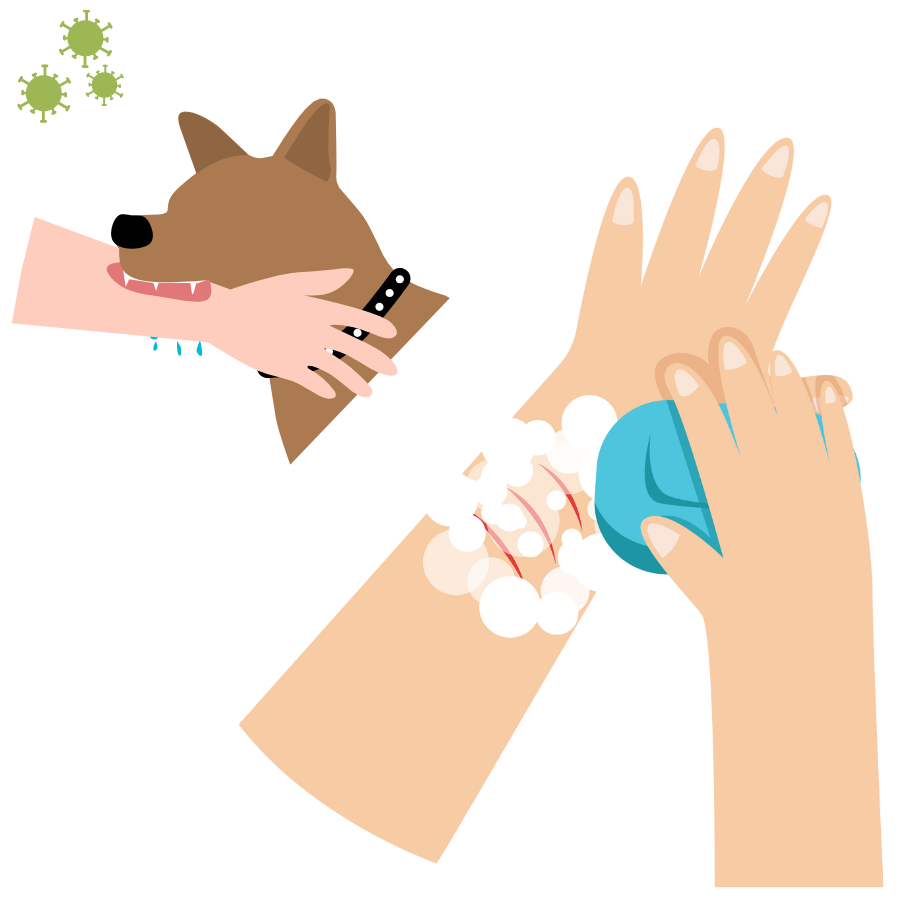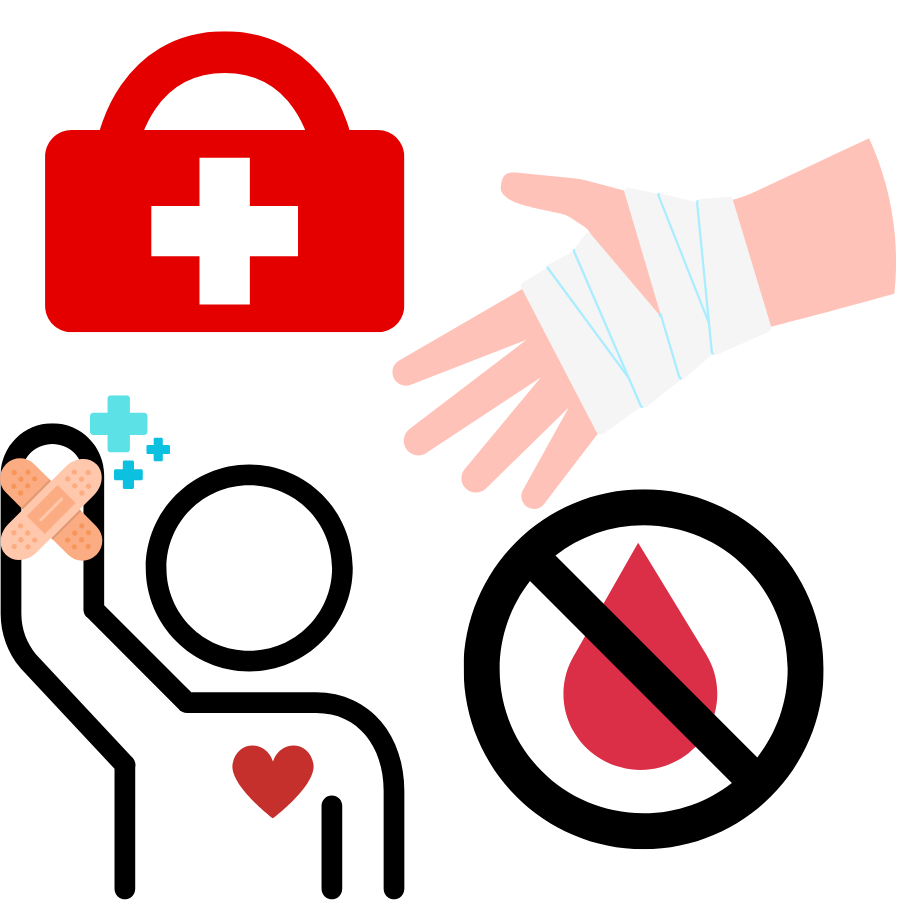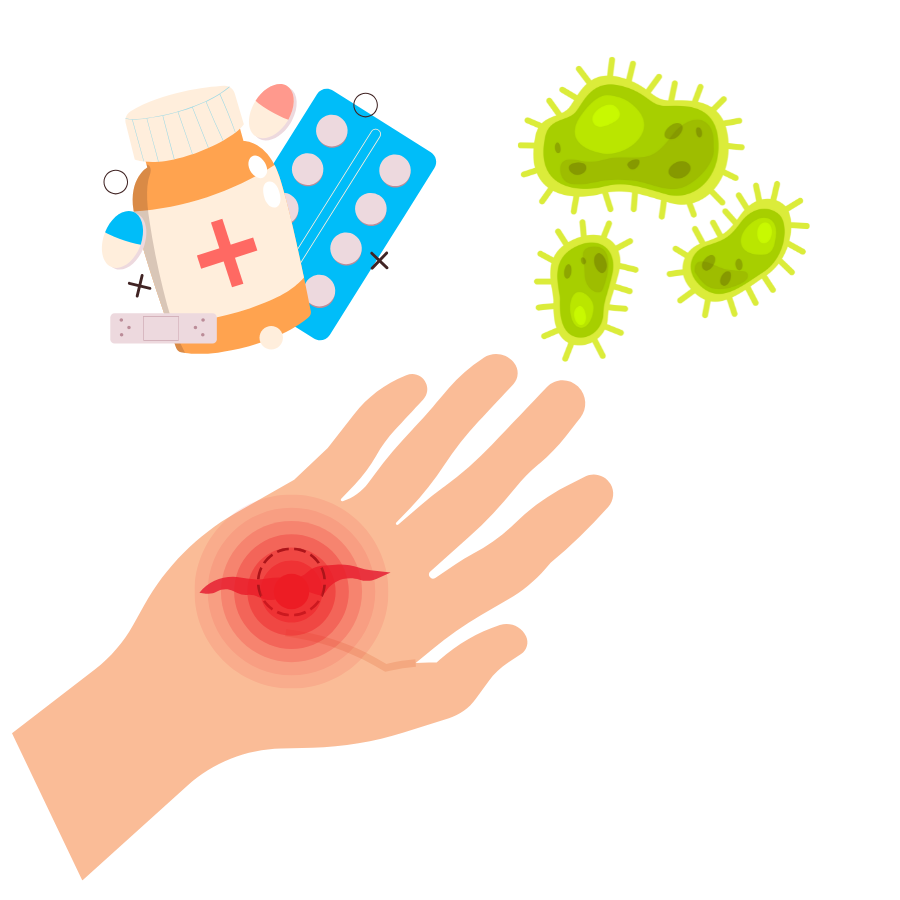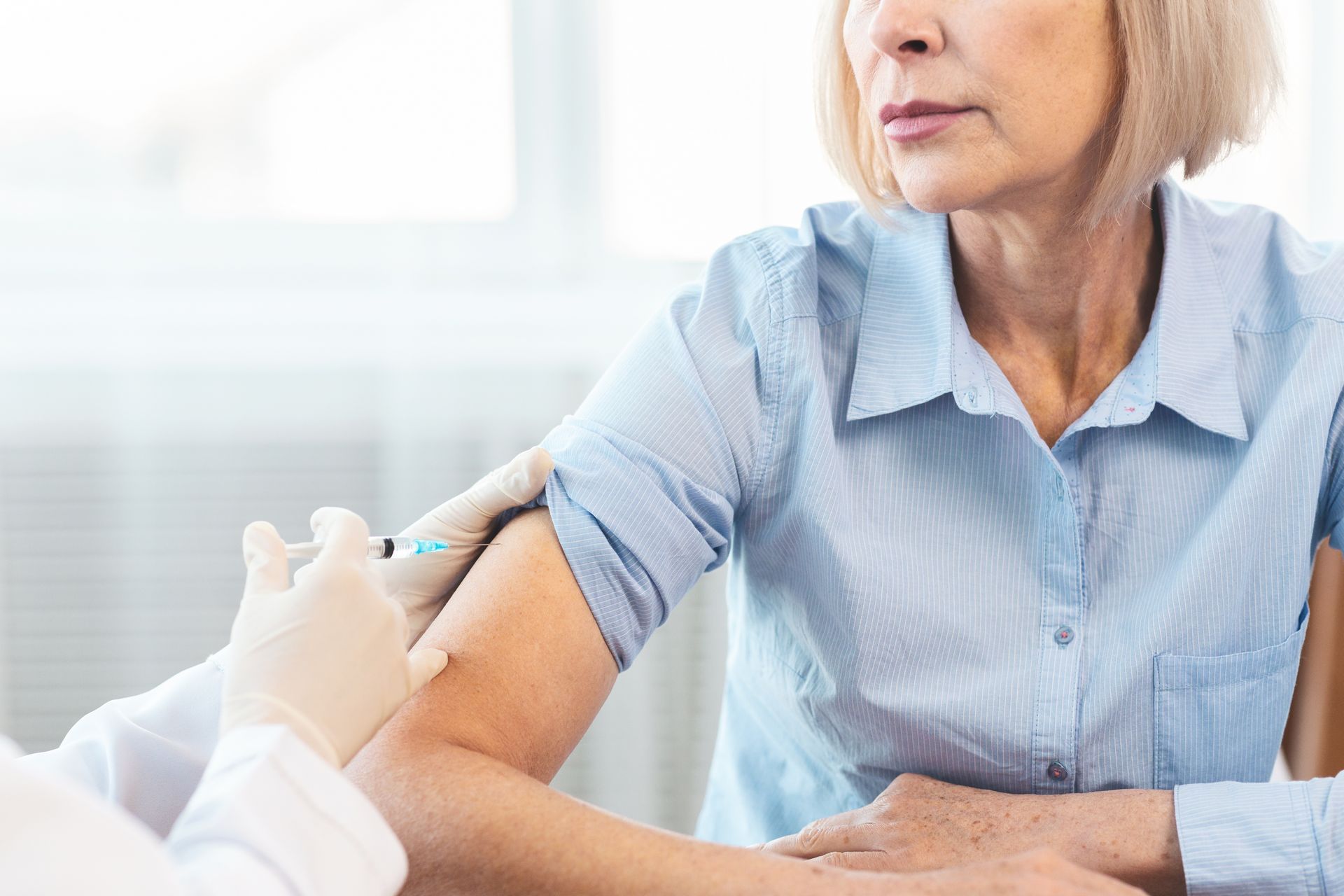Don't Call Christina Later, Call Christina Now
Follow us
What Immediate Medical Care Is Required After a Dog Bite?
Essential Steps to Take Right After a Dog Bite to
Ensure Proper Care and Prevent Complications

Dog bites can happen unexpectedly and can range from minor scratches to more serious injuries. Whether the bite is from your own dog or a stray, knowing what immediate medical care is required can help prevent infections, reduce the risk of serious complications, and ensure a faster recovery. In this blog, we’ll outline the key steps to take immediately after a dog bite to protect your health and promote healing.

Why Immediate Medical Care is Crucial After a Dog Bite
A dog bite can lead to infections, nerve damage, or in rare cases, life-threatening conditions like rabies. Prompt medical care is essential for minimizing these risks. Even minor bites can lead to complications if not treated correctly. Getting the right care as soon as possible can reduce the chances of infection and speed up recovery.

Step 1: Clean the Wound Immediately
What to Do:
Wash the Bite Area: Use mild soap and clean, running water to wash the bite. This helps remove dirt, bacteria, or saliva that might have been transferred during the bite.
Avoid Scrubbing: Gently cleanse the wound, but avoid scrubbing it too hard, as this could cause further damage or push bacteria deeper into the skin.
Why It’s Important:
Cleaning the wound as soon as possible helps prevent infections. Bacteria from the dog’s mouth or the environment could enter the wound, leading to potential infections like cellulitis or, in severe cases, sepsis.
Step 1: Clean the Wound Immediately
What to Do:
Wash the Bite Area: Use mild soap and clean, running water to wash the bite. This helps remove dirt, bacteria, or saliva that might have been transferred during the bite.
Avoid Scrubbing: Gently cleanse the wound, but avoid scrubbing it too hard, as this could cause further damage or push bacteria deeper into the skin.
Why It’s Important: Cleaning the wound as soon as possible helps prevent infections. Bacteria from the dog’s mouth or the environment could enter the wound, leading to potential infections like cellulitis or, in severe cases, sepsis.


Step 2: Apply Pressure to Stop Bleeding
What to Do:
Use a Clean Cloth: Apply a clean cloth or sterile bandage to the wound and press firmly to stop any bleeding. If the bleeding doesn’t stop after several minutes of pressure, seek emergency medical help.
Elevate the Wound: If possible, raise the affected area above the level of the heart to minimize blood flow and reduce swelling.
Why It’s Important:
Proper pressure helps control bleeding, which is crucial for preventing excessive blood loss. If left untreated, bleeding could lead to complications, especially if the bite is deep or on a sensitive area like the face or hands.

Step 2: Apply Pressure to Stop Bleeding
What to Do:
Use a Clean Cloth: Apply a clean cloth or sterile bandage to the wound and press firmly to stop any bleeding. If the bleeding doesn’t stop after several minutes of pressure, seek emergency medical help.
Elevate the Wound: If possible, raise the affected area above the level of the heart to minimize blood flow and reduce swelling.
Why It’s Important: Proper pressure helps control bleeding, which is crucial for preventing excessive blood loss. If left untreated, bleeding could lead to complications, especially if the bite is deep or on a sensitive area like the face or hands.
Step 3: Apply an Antiseptic
What to Do:
Use Antiseptic Solution: After cleaning the bite, apply an antiseptic like hydrogen peroxide, iodine, or alcohol to disinfect the area.
Avoid Certain Products: Avoid using harsh chemicals like alcohol directly on the wound, as they can cause irritation and slow healing.
Why It’s Important:
Applying antiseptic reduces the risk of infection by killing harmful bacteria that may have entered the wound. Keeping the wound clean and disinfected is crucial in the initial stages of healing.
Step 3: Apply an Antiseptic
What to Do:
Use Antiseptic Solution: After cleaning the bite, apply an antiseptic like hydrogen peroxide, iodine, or alcohol to disinfect the area.
Avoid Certain Products: Avoid using harsh chemicals like alcohol directly on the wound, as they can cause irritation and slow healing.
Why It’s Important: Applying antiseptic reduces the risk of infection by killing harmful bacteria that may have entered the wound. Keeping the wound clean and disinfected is crucial in the initial stages of healing.
Clean, Running Water
- How to Use: The first step is to wash the bite with clean, running water. This helps remove dirt, saliva, and other debris from the wound.
- Why It's Safe: Water is gentle and won’t irritate the skin or tissue around the wound. It also helps to flush out harmful bacteria.
Mild Soap
- How to Use: After rinsing the wound with water, use a mild soap (like unscented baby soap) to clean the area gently.
- Why It's Safe: Mild soap helps remove any remaining bacteria or debris without causing irritation. Avoid using harsh soaps with fragrances or alcohol.
Saline Solution (Sterile)
- How to Use: You can use a sterile saline solution to rinse the wound after washing with soap and water. Saline solution can be purchased at a pharmacy, or you can make your own by mixing 1 teaspoon of salt in 1 cup of warm water.
- Why It's Safe: Saline solution is gentle on the skin and helps cleanse the wound without irritating or drying it out.
Antibiotic Ointment (e.g., Neosporin)
- How to Use: After cleaning the wound, apply a thin layer of antibiotic ointment to help prevent infection.
- Why It's Safe: Antibiotic ointments like Neosporin are effective at preventing infection and promoting healing. They provide a protective barrier on the wound.
Sterile Gauze or Bandage
- How to Use: Cover the wound with a sterile gauze pad or bandage to protect it from dirt and bacteria.
- Why It's Safe: A bandage helps to keep the area clean and reduces the risk of further contamination.
Hydrogen Peroxide (Low Concentration)
- How to Use: If you don’t have saline solution available, you can use a low concentration of hydrogen peroxide (3%) to disinfect the wound. However, use it sparingly, as frequent use can harm healthy tissue.
- Why It's Safe: Hydrogen peroxide helps kill bacteria but should not be overused because it can irritate the wound.
Alcohol-Free Antiseptic Wipes (Optional)
- How to Use: You can gently wipe the area around the wound with alcohol-free antiseptic wipes if necessary.
- Why It's Safe: Alcohol-free wipes are less likely to irritate the skin compared to those containing alcohol, but they can still help with cleaning the area around the bite.
Rubbing Alcohol
- Why to Avoid: Rubbing alcohol can be overly harsh on open wounds. While it’s commonly used as a disinfectant, it can dry out the wound and surrounding skin, leading to irritation and a slower healing process.
Hydrogen Peroxide (High Concentration)
- Why to Avoid: Hydrogen peroxide is a common antiseptic, but in higher concentrations, it can damage healthy tissue around the wound, impairing the healing process. Lower concentrations (like 3%) are generally safer but still should be used sparingly.
Iodine (Betadine)
- Why to Avoid: While iodine-based solutions like Betadine can disinfect wounds, they may also cause skin irritation in some people, especially if applied frequently. Overuse can slow healing and cause the skin to become dry.
Bleach
- Why to Avoid: Bleach is a powerful disinfectant but should never be used on open wounds. It can cause severe irritation and damage to the skin, leading to a higher risk of infection and delayed healing.
Strong Antiseptic Creams
- Why to Avoid: Some over-the-counter antiseptic creams contain strong chemicals (like alcohol or other drying agents) that may harm the wound rather than help it heal. These can lead to more dryness and irritation, making healing more difficult.
Perfumed or Alcohol-Based Lotion
- Why to Avoid: Lotions that contain fragrances or alcohol can irritate an open wound. The alcohol may cause a stinging sensation and dryness, which can slow the healing process.
Astringent Face Wipes
- Why to Avoid: Products like face wipes containing alcohol or strong astringents are designed to cleanse but can irritate cuts or wounds. They can dry out the skin and make it more prone to infection or scarring.
When to Seek Medical Attention:
- Deep or Severe Bite: If the bite is deep, large, or caused by a stray dog, seek medical help immediately. A doctor may need to clean the wound more thoroughly and decide if you need a tetanus shot or rabies vaccine.
- Signs of Infection: If the wound becomes red, swollen, warm, or starts oozing pus, consult a doctor as these are signs of infection.
- Rabies Risk: If the dog was unvaccinated or unknown, talk to a healthcare provider about rabies vaccination, especially if the dog was acting abnormally.
By following these steps, you can ensure that the dog bite is cleaned properly and reduce the risk of infection.
Step 4: Seek Medical Attention
When to See a Doctor:
For Deep or Large Bites: If the bite is deep, large, or punctures the skin, seek immediate medical care. A doctor may need to clean the wound more thoroughly, prescribe antibiotics, or even perform stitches.
For Bites on Sensitive Areas: Dog bites to the face, hands, feet, or joints require prompt medical attention due to the risk of damage to vital structures and the potential for serious infections.
For Unvaccinated or Stray Dogs: If the dog that bit you was unvaccinated or a stray, it’s important to see a doctor right away to determine the need for a tetanus shot, rabies vaccination, or other treatments.
If You Notice Signs of Infection: If the wound becomes red, swollen, warm to the touch, or begins to drain pus, these could be signs of infection and require professional medical care.
Why It’s Important:
A doctor will assess the severity of the bite and determine the best course of action. If necessary, they may administer a tetanus shot, rabies vaccine, or prescribe antibiotics to prevent infection. Rabies is a serious concern, and timely medical intervention can prevent this fatal disease from spreading.
Step 4: Seek Medical Attention
When to See a Doctor:
For Deep or Large Bites: If the bite is deep, large, or punctures the skin, seek immediate medical care. A doctor may need to clean the wound more thoroughly, prescribe antibiotics, or even perform stitches.
For Bites on Sensitive Areas: Dog bites to the face, hands, feet, or joints require prompt medical attention due to the risk of damage to vital structures and the potential for serious infections.
For Unvaccinated or Stray Dogs: If the dog that bit you was unvaccinated or a stray, it’s important to see a doctor right away to determine the need for a tetanus shot, rabies vaccination, or other treatments.
If You Notice Signs of Infection: If the wound becomes red, swollen, warm to the touch, or begins to drain pus, these could be signs of infection and require professional medical care.
Why It’s Important: A doctor will assess the severity of the bite and determine the best course of action. If necessary, they may administer a tetanus shot, rabies vaccine, or prescribe antibiotics to prevent infection. Rabies is a serious concern, and timely medical intervention can prevent this fatal disease from spreading.

Step 5: Monitor for Signs of Infection
What to Do:
Watch for Symptoms: Over the next several days, keep an eye on the bite area for signs of infection, such as increased redness, swelling, warmth, or pus. If you notice any of these symptoms, consult a doctor immediately.
Pain Management: Over-the-counter pain relievers, such as ibuprofen or acetaminophen, can help manage pain and reduce inflammation. Follow the dosage instructions carefully.
Why It’s Important:
Monitoring for infection ensures that any signs of complications are addressed quickly. Infections can spread rapidly if left untreated, so staying vigilant after the bite is key to a smooth recovery.
Step 5: Monitor for Signs of Infection
What to Do:
Watch for Symptoms: Over the next several days, keep an eye on the bite area for signs of infection, such as increased redness, swelling, warmth, or pus. If you notice any of these symptoms, consult a doctor immediately.
Pain Management: Over-the-counter pain relievers, such as ibuprofen or acetaminophen, can help manage pain and reduce inflammation. Follow the dosage instructions carefully.
Why It’s Important: Monitoring for infection ensures that any signs of complications are addressed quickly. Infections can spread rapidly if left untreated, so staying vigilant after the bite is key to a smooth recovery.


Step 6: Consider Rabies and Tetanus Shots
When They’re Necessary:
Rabies: If the dog that bit you was unvaccinated or behaving unusually (e.g., foaming at the mouth, aggressive), it’s critical to consult a healthcare provider about the need for a rabies vaccination. Rabies can be fatal if not treated promptly, so timely administration of the vaccine is crucial.
Tetanus: Tetanus shots are needed if the wound is deep or caused by a dog’s teeth, especially if you haven’t had a tetanus shot in the past 5 to 10 years.
Why It’s Important:
Rabies and tetanus are both serious diseases that can be fatal if left untreated. If the dog’s vaccination history is unknown or there’s any suspicion of infection, it’s better to err on the side of caution and seek medical treatment.

Step 6: Consider Rabies and Tetanus Shots
When They’re Necessary:
Rabies: If the dog that bit you was unvaccinated or behaving unusually (e.g., foaming at the mouth, aggressive), it’s critical to consult a healthcare provider about the need for a rabies vaccination. Rabies can be fatal if not treated promptly, so timely administration of the vaccine is crucial.
Tetanus: Tetanus shots are needed if the wound is deep or caused by a dog’s teeth, especially if you haven’t had a tetanus shot in the past 5 to 10 years.
Why It’s Important: Rabies and tetanus are both serious diseases that can be fatal if left untreated. If the dog’s vaccination history is unknown or there’s any suspicion of infection, it’s better to err on the side of caution and seek medical treatment.
Immediate Action Can Save Your Health
Knowing what immediate medical care is required after a dog bite can make all the difference in preventing serious complications. Clean the wound, stop the bleeding, apply antiseptics, and seek medical attention when necessary. The faster you act, the better your chances of avoiding infection or more severe injuries.
Quick & Reliable
We are available 24/7 to Guide You to Better Health.
CALL CHRISTINA NOW is here to help 24 hours a day, 7 days a week, offering free and compassionate support. When you call us, we'll listen to your concerns, understand the specifics of your accident, help you find medical care for your injuries, and connect you with a professional who can advise you on the legal aspects of your situation.
CALL CHRISTINA NOW specializes in assisting with Lawyer and Medical Accident matters. If you've been in a car, motorcycle, or truck accident—or any other kind of accident—contact us today for trustworthy support.
DISCLAIMER:
CALL CHISTINA NOW isn't a law firm and can't provide legal advice, but we can refer you to the right attorney who can.
All Rights Reserved | Call Christina Now
Copyright © Call Christina Now Offers All Rights Reserved 2025
View Our Privacy Policy | Terms & Conditions | Disclaimer
